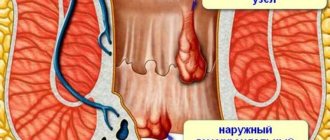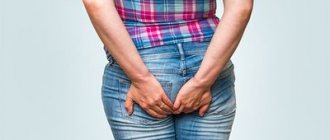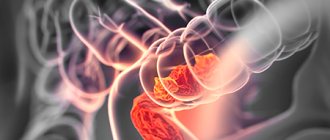For some reason, diseases of the large intestine, anus, and anus are considered something shameful. It is not customary to talk about them. Patients often delay seeing a doctor, preferring, due to some fictitious rules of decency, to worsen their health and quality of life.
Hemorrhoids are considered such an indecent disease. This should not be considered a punishment from God or the prerogative of the female half of humanity. Pathology does not select the height, age and gender of the patient. Internal hemorrhoids occur equally often in both men and women. What are the signs of internal hemorrhoids?
Hemorrhoids: classification
Hemorrhoids can be either internal or external.
Among ordinary people, this disease is clearly associated with the prolapse of hemorrhoids during bowel movements or heavy work. Doctors divide this pathology into 3 groups:
- External hemorrhoids are symptoms familiar to many
- Internal hemorrhoids are an invisible but no less unpleasant pathology.
- Combined type - combines all the features of the first two
How to distinguish from external?
In fact, this type of pathology differs little from the external habitual disease. But nodular seals form inside the rectum. Therefore, this variety does not have external manifestations. You will not be able to diagnose this disease yourself. Only an experienced proctologist can establish the correct diagnosis.
Causes of the disease
Doctors identify several main causes of this pathology:
- Poor nutrition – heavy, fatty foods. Modern people do not consume enough vegetables and fruits and cereal products. But he abuses sweets, fried meat, smoked meats and other unhealthy foods. This imbalance in nutrition leads to disturbances in bowel movements - constipation occurs. And the more often a patient reads books on the toilet, the higher the likelihood of developing hemorrhoids of any type.
- Lack of physical activity - sofa at home, working in an office, traveling exclusively by car - this is the appearance of a modern city dweller. This leads to congestion in the pelvic area. The result is one form or another of hemorrhoids.
- Alcohol – a little wine won’t hurt. But excessive doses of ethyl alcohol lead to disruption in the body’s vascular system. The result may be hemorrhoids, cirrhosis or fibrosis of the liver, and mental degradation.
- Physical activity - it would seem that all problems are due to lack of physical activity. But excessive lifting of weights and heavy physical labor also contribute to troubles in the anus.
Pregnancy in women is a type of heavy physical stress on the pelvic veins. In addition, while waiting for the baby, intestinal motility is disrupted, and women suffer from constipation. Childbirth also does not add health.
No one is immune from the development of hemorrhoids. But you have the power to protect yourself from unpleasant symptoms.
Causes
The anal canal is surrounded by cavernous plexuses. These vascular formations contain veins and arteries. Hemorrhoidal plexuses regulate blood flow in the anal canal area, which is necessary for the normal functioning of the rectum:
- fecal retention;
- defecation;
- providing an effective immune barrier between the internal environment of the body and the outside world.
Hemorrhoids are formed from the plexus vessels due to their inflammation, thrombosis and sclerosis, which develop under the influence of the following reasons:
- chronic constipation with regular straining during bowel movements;
- sedentary and especially “sedentary” lifestyle;
- excess body weight;
- pregnancy.
Hemorrhoids can develop with a permanent, and sometimes sudden, but very pronounced increase in intra-abdominal pressure, which disrupts the outflow of venous blood from the anorectal area. The causes of the development of internal hemorrhoids include chronic portal hypertension of various origins, subclinical disorders of blood flow in the portal vein system (with regular overeating, taking anabolic steroids, contraceptives, drinking alcohol, chronic drug intoxication). The development of external hemorrhoids is promoted by chronic injuries and inflammatory diseases of the anorectal area and pelvic organs (bacterial salpingoophoritis, cystitis, prostatitis). They lead to hemodynamic disturbances and lymphogenous spread of infection into the hemorrhoidal plexuses. Proctologists assign an important role in the development of hemorrhoids to hereditary predisposition to this disease.
Internal hemorrhoids 1st degree
It is very important to start treatment at stage 1 of hemorrhoids.
The general condition of a person with hemorrhoids may vary depending on the severity of the disease. Signs of 1st degree internal hemorrhoids:
- There are no external signs yet.
- Unpleasant feeling after visiting the toilet. Patients note itching and burning. Sometimes it feels like the rectum is being burst from the inside. And even complete emptying does not bring relief.
- Traces of blood after visiting the toilet or on underwear. This alarming sign may indicate not only the presence of hemorrhoids, but also tumor processes in the rectum.
- Mucous discharge from the rectum. Characteristic only for internal hemorrhoids. Causes hyperemia and swelling of the external parts of the anus.
- Constipation. The more often this happens, the faster the disease progresses. Feces become compacted, and during defecation they irritate and injure the internal mucous membranes of the rectum and existing nodes. The process of going to the toilet becomes an unpleasant and painful procedure.
If treatment is not started, the disease moves to the next stage.
What methods of eliminating hemorrhoids do doctors offer?
If the patient is categorically against surgical treatment of hemorrhoids, specialists select other methods of therapy. Since doctors treat primarily using traditional methods, the solutions they offer include:
- lifestyle correction - physical activity and diet;
- drug treatment;
- minimally invasive procedures;
Drug treatment
Suitable for eliminating hemorrhoids in the initial stages. As the disease progresses, they can be used only to relieve symptoms, stop bleeding, and reduce the inflammatory process.
Oral and local agents are used:
- tablets, mainly with angioprotective and venotonic effects - Detralex, Phlebodia and others;
- ointments and suppositories with anti-inflammatory, hemostatic and regenerating effects - with ichthyol, sea buckthorn oil, methyluracil, hydrocortisol, belladonna;
- non-steroidal anti-inflammatory drugs to eliminate the main symptoms of the disease in the form of suppositories, ointments and tablets;
- local anesthetics in the form of suppositories, gels and ointments.
Important! Any medicine, even if it is positioned by the manufacturer as safe, can be used only after consultation with the attending physician!
Minimally invasive procedures
The main advantage of this method of treating hemorrhoids is the radical elimination of nodes with minimal trauma. The list of minimally invasive treatment procedures includes:
- disarterization of hemorrhoidal veins;
- ligation with latex rings;
- sclerotherapy;
- infrared coagulation;
- electrocoagulation;
- cryodestruction.
Treatment with these methods does not require hospitalization. Moreover, after them the patient can return home or to work within a few hours (if it does not involve heavy physical activity).
Unfortunately, minimally invasive methods of treating hemorrhoids have complications and contraindications, which you should find out about in advance from a proctologist.
Lifestyle correction
This method of combating hemorrhoids involves eliminating factors that can lead to exacerbation of the disease and its progression, such as:
- Poor nutrition. During the treatment of hemorrhoids, the diet should be balanced, and foods should be selected from those that do not cause constipation. The basis of the diet should be vegetables and cereals, dairy products, fruits, eggs and dietary meat. You need to eat regularly, without fasting or overeating. Another goal of the diet, in addition to normalizing stool, is weight loss, especially if the patient has excessive fat deposits.
- Physical activity. For good blood circulation in the pelvis, it is important not to sit still. Regular gymnastic exercises, which are recommended to be done during breaks between work, a set of Skittle exercises, and swimming will be useful. Even regular walking with high knees can significantly improve the condition of patients with hemorrhoids. You should refrain from heavy loads, especially if they involve lifting weights.
- Bad habits. Drinking alcohol and smoking have an extremely negative effect on the condition of blood vessels. They are often the main cause of varicose veins, including hemorrhoids. If the first signs of hemorrhoids appear, you should give up nicotine and alcoholic beverages, or sharply limit their use.
Internal hemorrhoids stage 2
The situation is getting worse. Main symptoms of stage 2:
- Bleeding from the anus. If at first there were traces of blood, now it is full-fledged bleeding of a bright scarlet color.
- Loss of nodes means that the disease is advanced. Sometimes you can fix it yourself, but most often you have to see a doctor.
These unpleasant symptoms begin to bother you after physical activity, coughing, sneezing, even at rest. This indicates the advanced stage of the disease.
Diagnostic measures
Anoscopy is a method for diagnosing hemorrhoids.
In the early stages, it is impossible to diagnose this disease yourself. Only an experienced doctor is able to determine the type of disease and its stage. Instrumental methods are used to diagnose internal hemorrhoids:
- Anoscopy - the doctor examines the inner surface of the rectum using a special endoscope. The procedure is performed on an outpatient basis and does not require anesthesia or special preparation - a cleansing enema is sufficient. The doctor has the opportunity to examine 14 cm of the rectum. Contraindication – acute inflammatory process in the anal area.
- Sigmoidoscopy - the procedure is similar to anoscopy, but allows you to examine up to 25 cm of the rectum and colon. At the same time, a tissue biopsy is performed. The procedure is also performed on an outpatient basis, without anesthesia, and is allowed even for preschool children. Contraindication – bleeding from the anus in the active phase.
Preparation for sigmoidoscopy is as follows:
- Gentle diet
- Several sessions of cleansing enemas throughout the day
- Irrigoscopy is an x-ray examination of the rectum and colon using a contrast agent.
- Colonoscopy is used not only for diagnostic purposes, but also for treatment.
- Digital examination - in this case, it is used only for diagnosing nodes located in the immediate vicinity of the anus.
Treatment tactics
Infrared photocoagulation is a procedure for eliminating hemorrhoids.
Treatment of the patient depends on the diagnosis and severity of the disease. Your doctor may suggest the following methods:
- Conservative
- Minimally invasive procedures
- Surgical intervention
The conservative method involves the use of various medications. The best option for internal hemorrhoids is rectal suppositories and tablet forms. NSAIDs, sea buckthorn suppositories, and belladonna suppositories are used as local treatment. For oral administration, venotonics are prescribed - Detralex, Phlebodia and similar drugs. Minimally invasive procedures for internal hemorrhoids:
- Infrared photocoagulation is the effect of light quanta on the affected area. The nodes shrink and dry out.
- The procedure is performed on an outpatient basis. The disadvantage of this method is the likelihood of blood clots forming at the treatment site.
- Ligation with special latex rings. An anoscope is used for this procedure. It's simple - the nodes are pulled together in rings, blood circulation is disrupted and the tumor dies. The intervention, although effective, is quite painful. During 1 visit to the doctor, only 1 node is processed.
Other methods - laser coagulation, cryodestruction - similar photocoagulation are carried out according to indications and at the choice of the attending physician.
What to do for pain due to hemorrhoids
Some recommendations that will help relieve unwanted symptoms of hemorrhoids:
- to relieve pain, it is recommended to use sitz baths with warm water, lasting about 15 minutes, two or three times a day, after each trip to the toilet,
- Ice will help relieve swelling and pain. Place a small ice pack wrapped in a towel on the affected area. Use ice several times a day
- Painkillers will help you cope with the pain,
- try not to damage the hemorrhoids, so as not to cause bleeding or increase pain and irritation,
- avoid spending long periods of time sitting on the toilet,
- use wet wipes to reduce irritation,
- local use of ointments and anal suppositories that contain an anti-inflammatory or analgesic component will help cope with pain and itching,
- Increasing the amount of fiber, fluids, or using a laxative drug will help avoid straining and damaging the hemorrhoids during bowel movements.
If pain persists for more than 3-4 days, you should seek medical help from a doctor. Yusupov Hospital is one of the leading medical institutions that treat hemorrhoidal vein thrombosis of any severity. The hospital receives patients 24 hours a day. The hospital’s highly specialized medical team allows us to provide fast and high-quality medical care at any time of the day or night, and the patient rooms are equipped with everything necessary for a comfortable stay for the patient during treatment.
Rating of the top 10 inexpensive and effective ointments for hemorrhoids according to KP
First group of drugs:
Relief Advance
Relief advance. Signature: FAMAR SA (Greece)
Relief Advance ointment contains the local anesthetic benzocaine. Pain relief is the first step in the symptomatic treatment of hemorrhoids with severe pain.
This remedy is indicated for:
- hemorrhoids,
- anal fissures,
- after proctological operations,
- during diagnostic procedures.
For ease of use, the ointment is equipped with a special tip. Relief Advance is contraindicated in persons with thrombosis and children under 12 years of age.
show more








